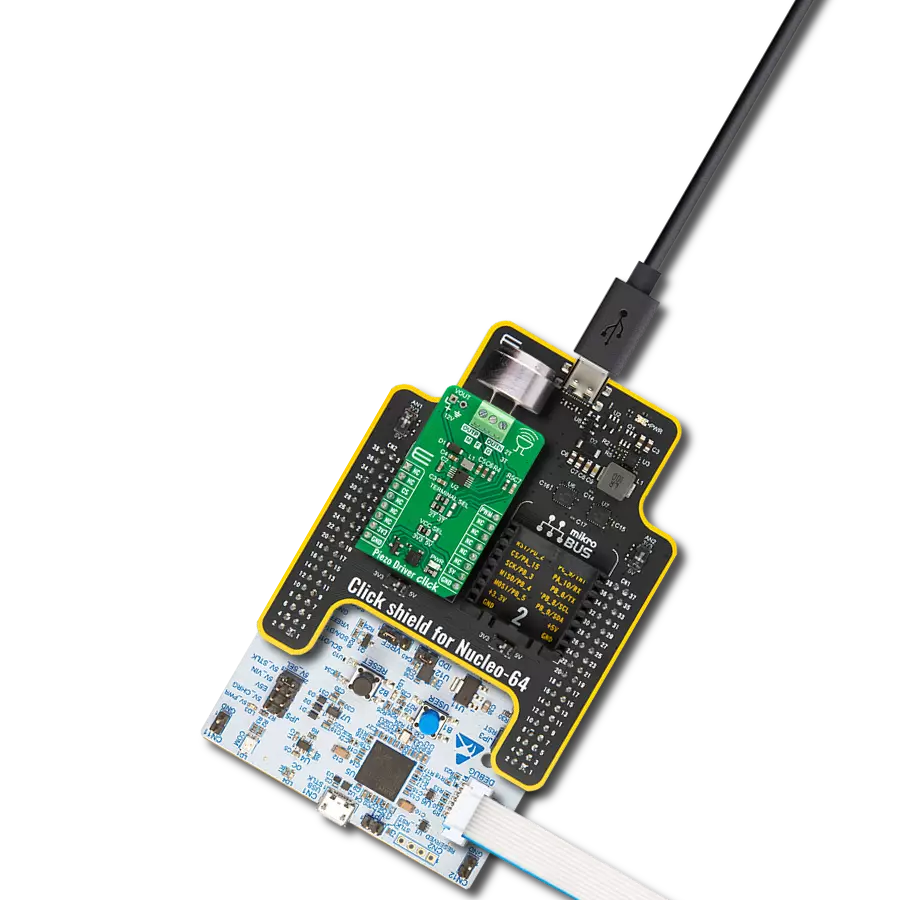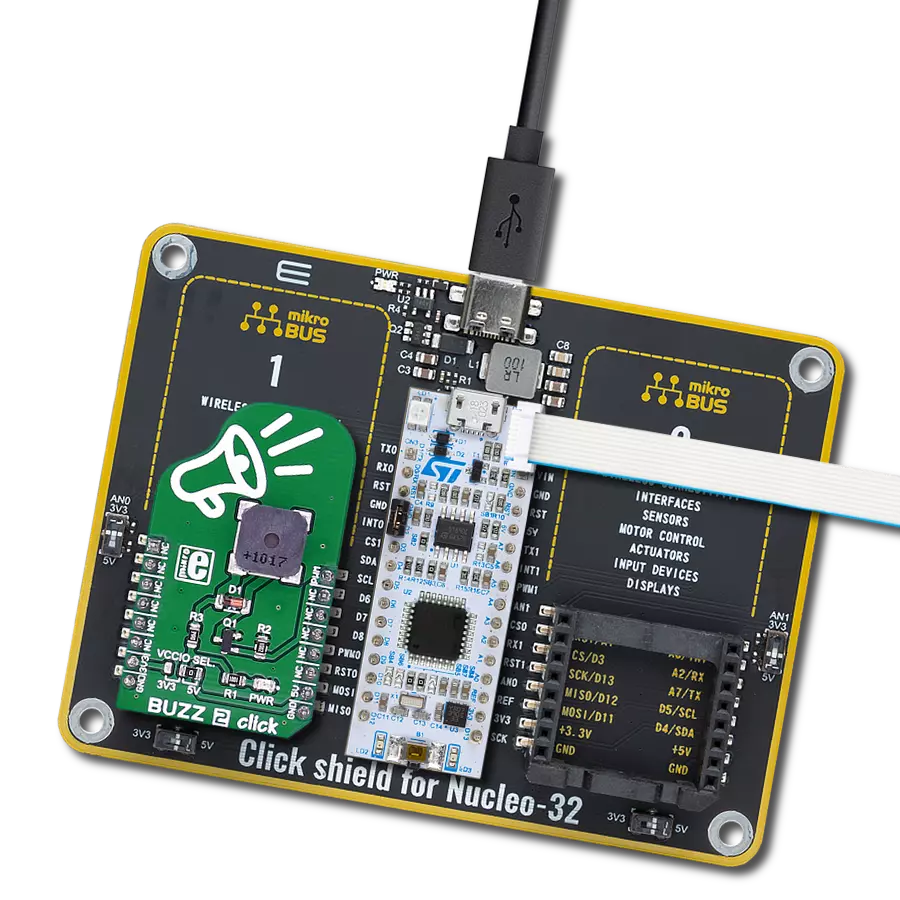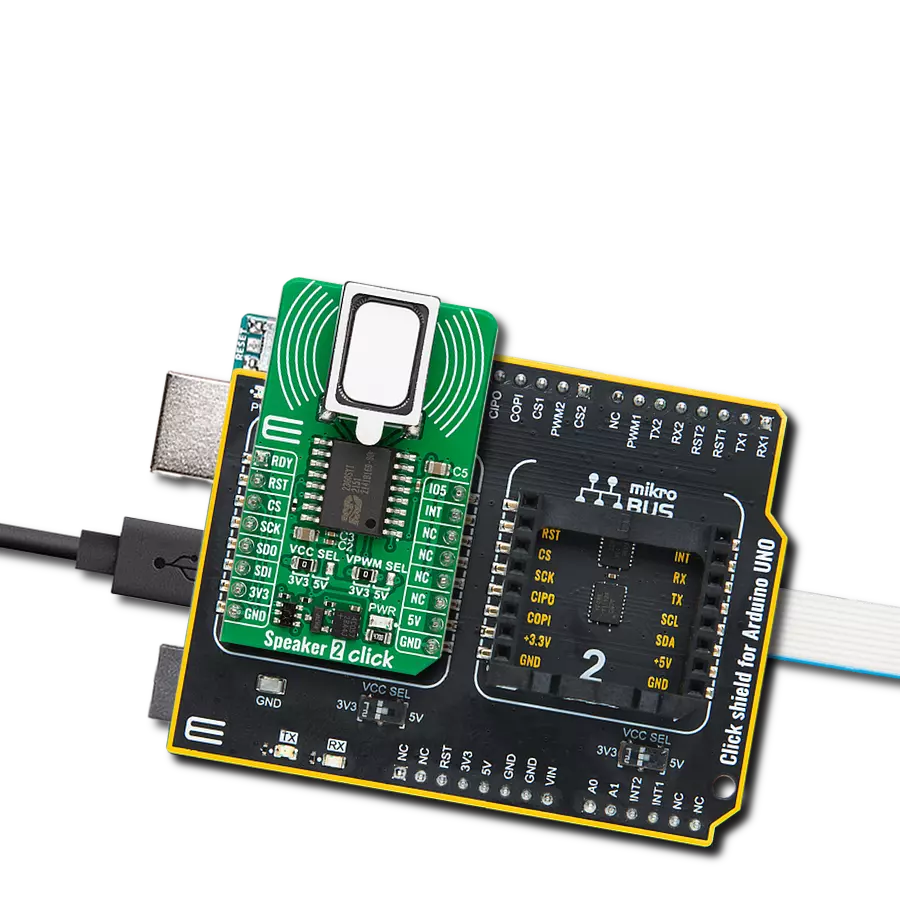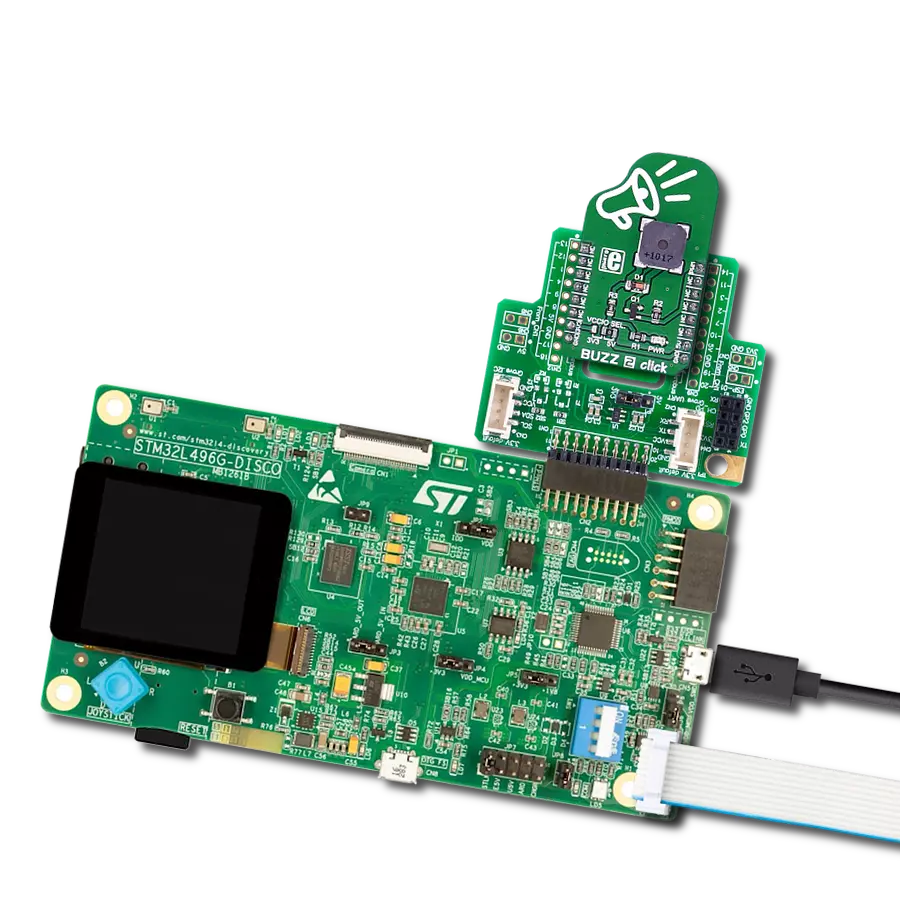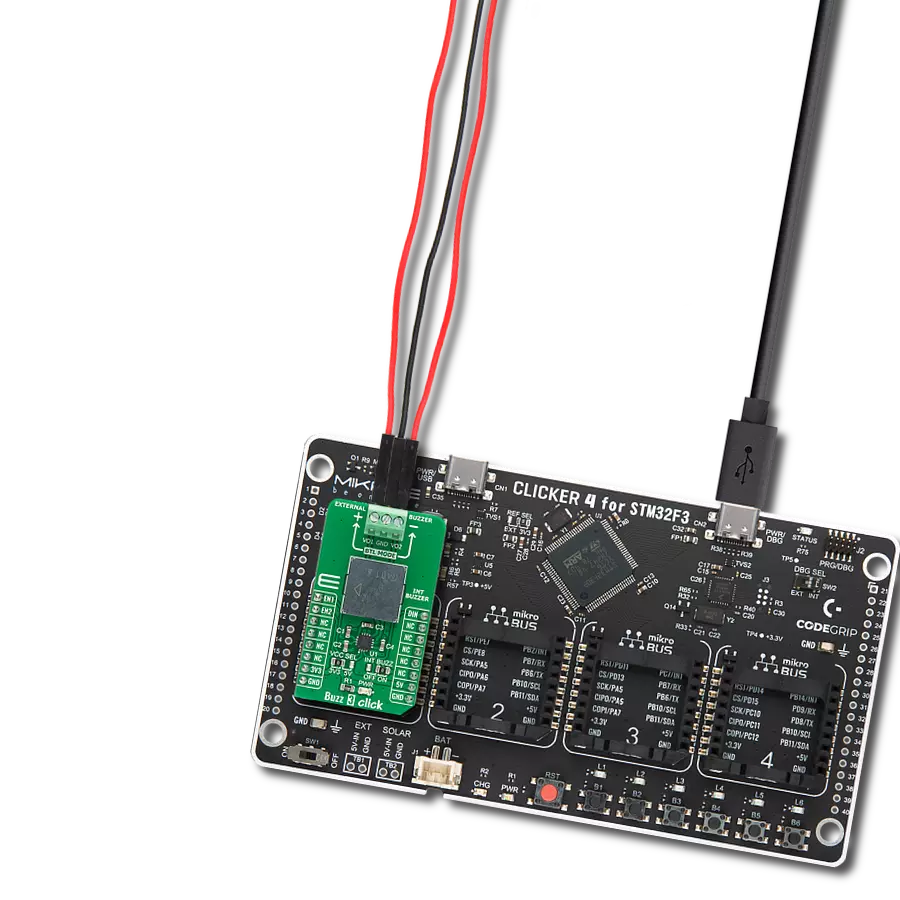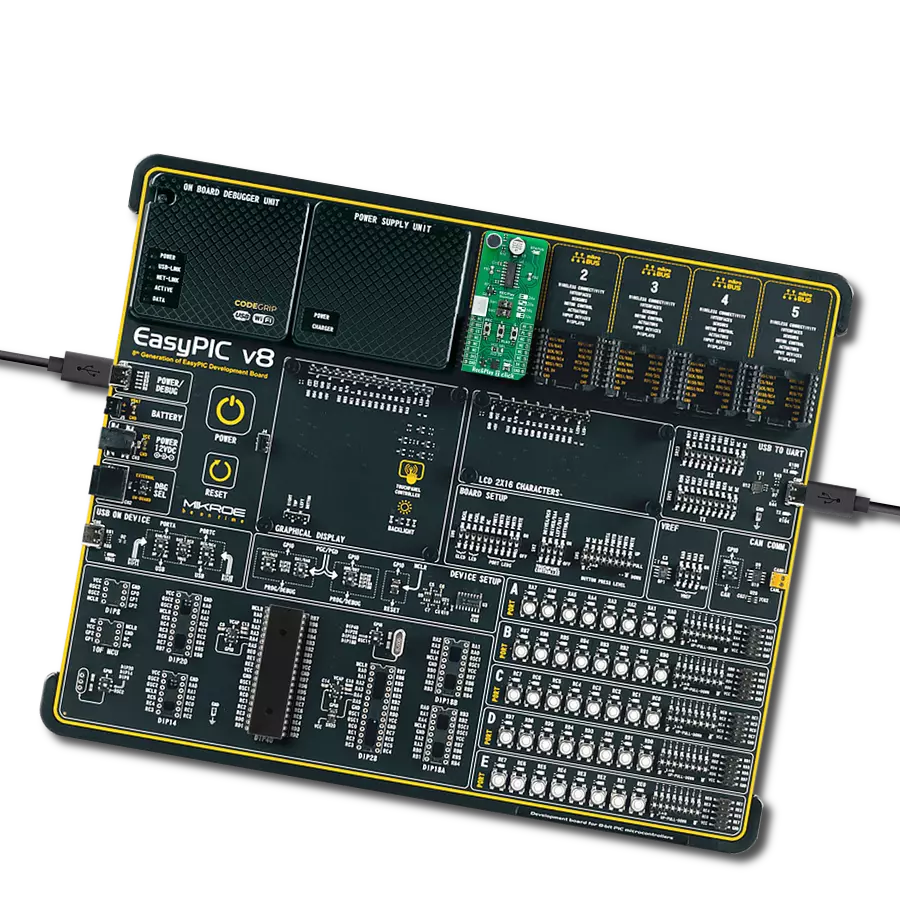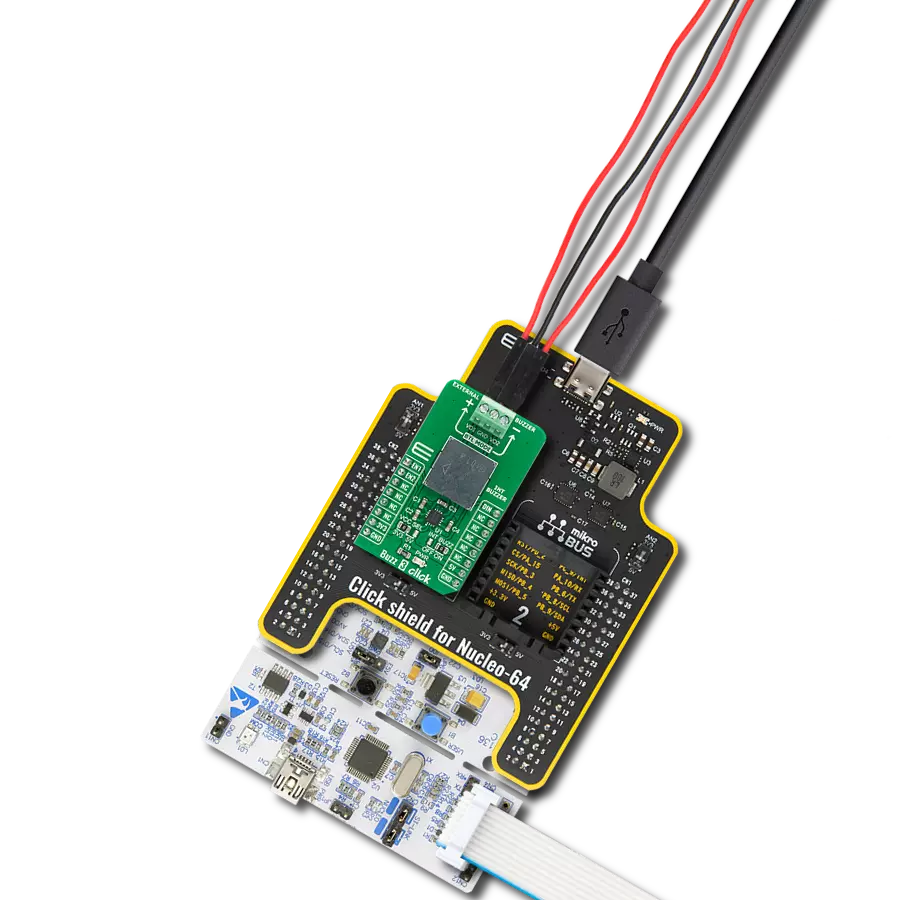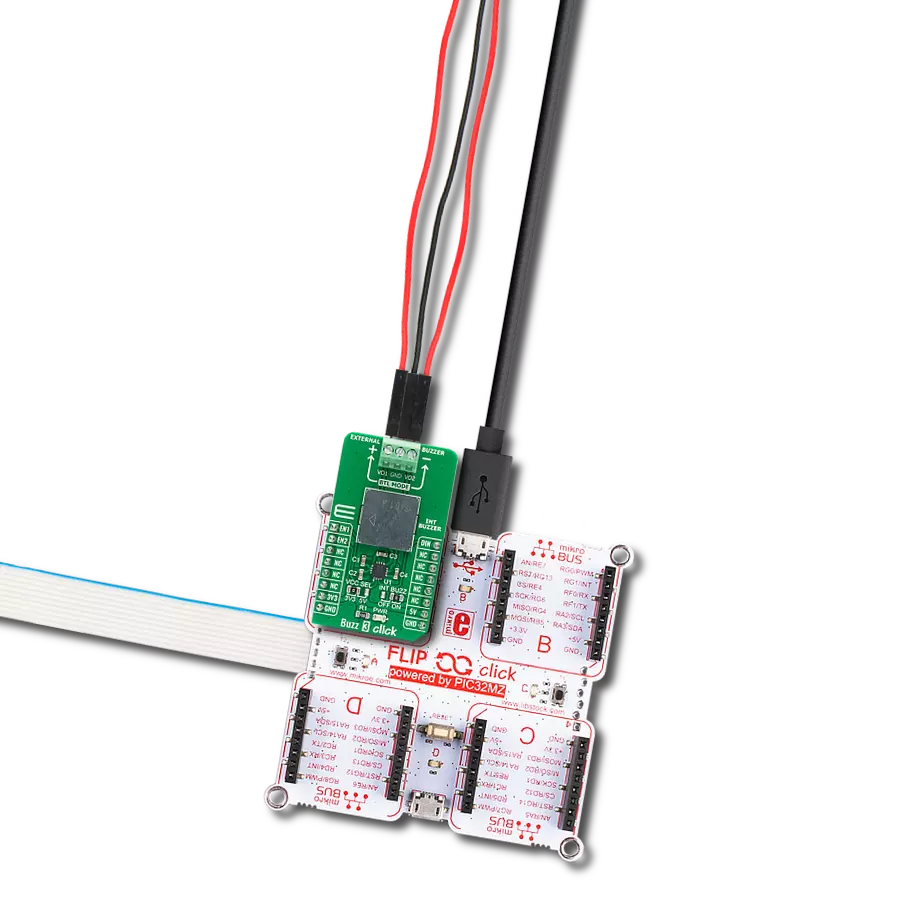多功能且紧凑的解决方案,用于在各种电子应用中添加音频信号功能,满足不同领域开发者和工程师的需求。
A
A
硬件概览
它是如何工作的?
Buzz Click 基于 Sanco Electronics 的压电换能器 EPT-14A4005P。它使用直流电压产生音频信号,最大电流消耗为 2mA,工作电压宽广,本例中为 3.3V 或 5V。正如其名称所示,压电蜂鸣器的核心包括压电陶瓷元件和金属板,两者通过粘合剂固定在一起。当通过直流电时,压电陶瓷元件收缩和扩张,这会引起振动并产生声波。蜂鸣器的共振频率为 4000Hz,在 此频率下蜂鸣器振动,从而发出声音。蜂鸣器的尺寸
为 13.8x6.8mm,除了在这个 Click 板™上使用外,还可以从 MIKROE 单独购买。板载蜂鸣器驱动器可以通过数字 GPI 引脚或 mikroBUS™ 插座的 PWM 线路控制。用户可以使用 MIKROE 编译器支持的 Sound 库来创建声音,或使用微控制器内部的 PWM 模块来为蜂鸣器生成信号。信号频率决定声音的音调,占空比决定幅度(声音音量)。GPI 和 PWM 线默认连接 到蜂鸣器。用户可以通过移除相应的跳线(J2 或
J3)来分离其中一条线路。此 Click 板™可以通过 PWR SEL 跳线选择使用 3.3V 或 5V 逻辑电压水平运行。这样,3.3V 和 5V 兼容的 MCU 都可以正确使用通信线路。此外,这个 Click 板™配备了一个库,其中包含易于使用的功能和示例代码,可以用作进一步开发的参考。
功能概述
开发板
PIC32MZ Clicker 是一款紧凑型入门开发板,它将 Click 板™的灵活性带给您喜爱的微控制器,使其成为实现您想法的完美入门套件。它配备了一款板载 32 位带有浮点单元的 Microchip PIC32MZ 微控制器,一个 USB 连接器,LED 指示灯,按钮,一个 mikroProg 连接器,以及一个用于与外部电子设备接口的头部。得益于其紧凑的设计和清晰易识别的丝网标记,它提供了流畅且沉浸式的工作体验,允许在任
何情况下、任何地方都能访问。PIC32MZ Clicker 开 发套件的每个部分都包含了使同一板块运行最高效的必要组件。除了可以选择 PIC32MZ Clicker 的编程方式,使用 USB HID mikroBootloader 或通过外部 mikroProg 连接器为 PIC,dsPIC 或 PIC32 编程外,Clicker 板还包括一个干净且调节过的开发套件电源供应模块。USB Micro-B 连接可以提供多达 500mA 的电流,这足以操作所有板载和附加模块。所有
mikroBUS™ 本身支持的通信方法都在这块板上,包 括已经建立良好的 mikroBUS™ 插槽、重置按钮以及若干按钮和 LED 指示灯。PIC32MZ Clicker 是 Mikroe 生态系统的一个组成部分,允许您在几分钟内创建新的应用程序。它由 Mikroe 软件工具原生支持,得益于大量不同的 Click 板™(超过一千块板),其数量每天都在增长,它涵盖了原型制作的许多方面。
微控制器概述
MCU卡片 / MCU
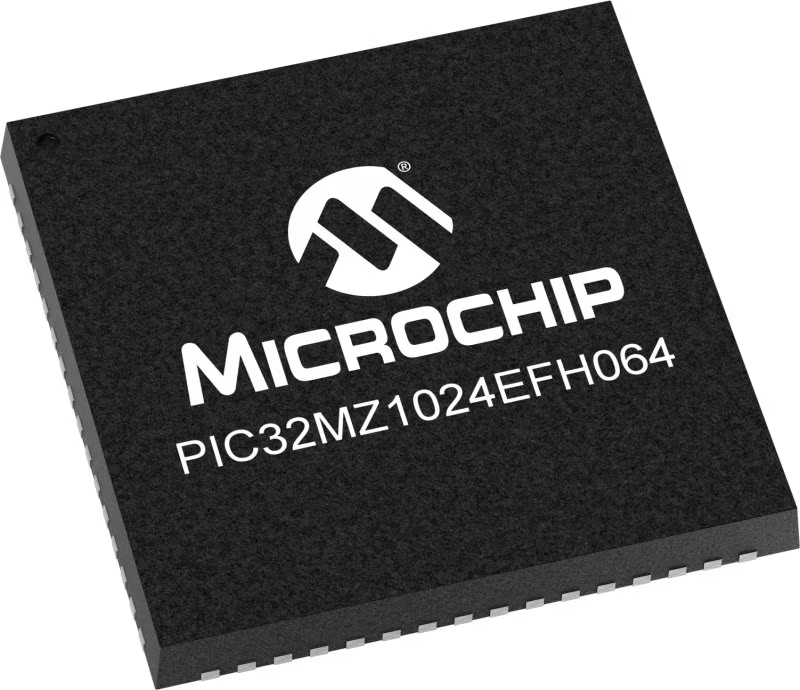
建筑
PIC32
MCU 内存 (KB)
1024
硅供应商
Microchip
引脚数
64
RAM (字节)
524288
使用的MCU引脚
mikroBUS™映射器
“仔细看看!”
Click board™ 原理图

一步一步来
项目组装
软件支持
库描述
此库包含 BUZZ Click 驱动程序的 API。
关键功能:
buzz_set_duty_cycle- 此功能设置 PWM 占空比,以百分比表示(范围 [0..1])buzz_pwm_stop- 此功能停止 PWM 模块输出buzz_pwm_start- 此功能启动 PWM 模块输出buzz_play_sound- 此功能在蜂鸣器上播放声音
开源
代码示例
完整的应用程序代码和一个现成的项目可以通过NECTO Studio包管理器直接安装到NECTO Studio。 应用程序代码也可以在MIKROE的GitHub账户中找到。
/*!
* @file main.c
* @brief BUZZ Click example
*
* # Description
* This example demonstrates the use of Buzz Click boards.
*
* The demo application is composed of two sections :
*
* ## Application Init
* Initializes the driver and logger.
*
* ## Application Task
* Plays the Imperial March melody. Also logs an appropriate message on the USB UART.
*
* ## Additional Functions
* imperial_march( void ) - this function plays the Imperial March melody.
*
* @note
* The minimal PWM Clock frequency required for this example is the frequency of tone C6 - 1047 Hz.
* So, in order to run this example and play all tones correctly, the user will need to decrease
* the MCU's main clock frequency in MCU Settings for the certain architectures
* in order to get the required PWM clock frequency.
*
* @author Stefan Ilic
*
*/
#include "board.h"
#include "log.h"
#include "buzz.h"
#define W 4*Q // Whole 4/4 - 4 Beats
#define H 2*Q // Half 2/4 - 2 Beats
#define Q 250 // Quarter 1/4 - 1 Beat
#define E Q/2 // Eighth 1/8 - 1/2 Beat
#define S Q/4 // Sixteenth 1/16 - 1/4 Beat
#define VOLUME 100 // goes up to 1000
static buzz_t buzz;
static log_t logger;
static void imperial_march( ) {
buzz_play_sound( &buzz, BUZZ_NOTE_A6, VOLUME, Q );
Delay_ms ( 1 + Q );
buzz_play_sound( &buzz, BUZZ_NOTE_A6, VOLUME, Q );
Delay_ms ( 1 + Q );
buzz_play_sound( &buzz, BUZZ_NOTE_A6, VOLUME, Q );
Delay_ms ( 1 + Q );
buzz_play_sound( &buzz, BUZZ_NOTE_F6, VOLUME, E + S );
Delay_ms ( 1 + E + S );
buzz_play_sound( &buzz, BUZZ_NOTE_C7, VOLUME, S );
Delay_ms ( 1 + S );
buzz_play_sound( &buzz, BUZZ_NOTE_A6, VOLUME, Q );
Delay_ms ( 1 + Q );
buzz_play_sound( &buzz, BUZZ_NOTE_F6, VOLUME, E + S );
Delay_ms ( 1 + E + S );
buzz_play_sound( &buzz, BUZZ_NOTE_C7, VOLUME, S );
Delay_ms ( 1 + S );
buzz_play_sound( &buzz, BUZZ_NOTE_A6, VOLUME, H );
Delay_ms ( 1 + H );
buzz_play_sound( &buzz, BUZZ_NOTE_E7, VOLUME, Q );
Delay_ms ( 1 + Q );
buzz_play_sound( &buzz, BUZZ_NOTE_E7, VOLUME, Q );
Delay_ms ( 1 + Q );
buzz_play_sound( &buzz, BUZZ_NOTE_E7, VOLUME, Q );
Delay_ms ( 1 + Q );
buzz_play_sound( &buzz, BUZZ_NOTE_F7, VOLUME, E + S );
Delay_ms ( 1 + E + S );
buzz_play_sound( &buzz, BUZZ_NOTE_C7, VOLUME, S );
Delay_ms ( 1 + S );
buzz_play_sound( &buzz, BUZZ_NOTE_Ab6, VOLUME, Q );
Delay_ms ( 1 + Q );
buzz_play_sound( &buzz, BUZZ_NOTE_F6, VOLUME, E + S );
Delay_ms ( 1 + E + S );
buzz_play_sound( &buzz, BUZZ_NOTE_C7, VOLUME, S );
Delay_ms ( 1 + S );
buzz_play_sound( &buzz, BUZZ_NOTE_A6, VOLUME, H );
Delay_ms ( 1 + H );
buzz_play_sound( &buzz, BUZZ_NOTE_A7, VOLUME, Q );
Delay_ms ( 1 + Q );
buzz_play_sound( &buzz, BUZZ_NOTE_A6, VOLUME, E + S );
Delay_ms ( 1 + E + S );
buzz_play_sound( &buzz, BUZZ_NOTE_A6, VOLUME, S );
Delay_ms ( 1 + S );
buzz_play_sound( &buzz, BUZZ_NOTE_A7, VOLUME, Q );
Delay_ms ( 1 + Q );
buzz_play_sound( &buzz, BUZZ_NOTE_Ab7, VOLUME, E + S );
Delay_ms ( 1 + E + S );
buzz_play_sound( &buzz, BUZZ_NOTE_G7, VOLUME, S );
Delay_ms ( 1 + S );
buzz_play_sound( &buzz, BUZZ_NOTE_Gb7, VOLUME, S );
Delay_ms ( 1 + S );
buzz_play_sound( &buzz, BUZZ_NOTE_E7, VOLUME, Q );
Delay_ms ( 1 + Q );
buzz_play_sound( &buzz, BUZZ_NOTE_F7, VOLUME, E );
Delay_ms ( 1 + E );
Delay_ms ( 1 + E );
buzz_play_sound( &buzz, BUZZ_NOTE_Bb6, VOLUME, E );
Delay_ms ( 1 + E );
buzz_play_sound( &buzz, BUZZ_NOTE_Eb7, VOLUME, Q );
Delay_ms ( 1 + Q );
buzz_play_sound( &buzz, BUZZ_NOTE_D7, VOLUME, E + S );
Delay_ms ( 1 + E + S );
buzz_play_sound( &buzz, BUZZ_NOTE_Db7, VOLUME, S );
Delay_ms ( 1 + S );
buzz_play_sound( &buzz, BUZZ_NOTE_C7, VOLUME, S );
Delay_ms ( 1 + S );
buzz_play_sound( &buzz, BUZZ_NOTE_B6, VOLUME, S );
Delay_ms ( 1 + S );
buzz_play_sound( &buzz, BUZZ_NOTE_C7, VOLUME, E );
Delay_ms ( 1 + E );
Delay_ms ( 1 + E );
buzz_play_sound( &buzz, BUZZ_NOTE_F6, VOLUME, E );
Delay_ms ( 1 + E );
buzz_play_sound( &buzz, BUZZ_NOTE_Ab6, VOLUME, Q );
Delay_ms ( 1 + Q );
buzz_play_sound( &buzz, BUZZ_NOTE_F6, VOLUME, E + S );
Delay_ms ( 1 + E + S );
buzz_play_sound( &buzz, BUZZ_NOTE_A6, VOLUME, S );
Delay_ms ( 1 + S );
buzz_play_sound( &buzz, BUZZ_NOTE_C7, VOLUME, Q );
Delay_ms ( 1 + Q );
buzz_play_sound( &buzz, BUZZ_NOTE_A6, VOLUME, E + S );
Delay_ms ( 1 + E + S );
buzz_play_sound( &buzz, BUZZ_NOTE_C7, VOLUME, S );
Delay_ms ( 1 + S );
buzz_play_sound( &buzz, BUZZ_NOTE_E7, VOLUME, H );
Delay_ms ( 1 + H );
buzz_play_sound( &buzz, BUZZ_NOTE_A7, VOLUME, Q );
Delay_ms ( 1 + Q );
buzz_play_sound( &buzz, BUZZ_NOTE_A6, VOLUME, E + S );
Delay_ms ( 1 + E + S );
buzz_play_sound( &buzz, BUZZ_NOTE_A6, VOLUME, S );
Delay_ms ( 1 + S );
buzz_play_sound( &buzz, BUZZ_NOTE_A7, VOLUME, Q );
Delay_ms ( 1 + Q );
buzz_play_sound( &buzz, BUZZ_NOTE_Ab7, VOLUME, E + S );
Delay_ms ( 1 + E + S );
buzz_play_sound( &buzz, BUZZ_NOTE_G7, VOLUME, S );
Delay_ms ( 1 + S );
buzz_play_sound( &buzz, BUZZ_NOTE_Gb7, VOLUME, S );
Delay_ms ( 1 + S );
buzz_play_sound( &buzz, BUZZ_NOTE_E7, VOLUME, S );
Delay_ms ( 1 + S );
buzz_play_sound( &buzz, BUZZ_NOTE_F7, VOLUME, E );
Delay_ms ( 1 + E );
Delay_ms ( 1 + E );
buzz_play_sound( &buzz, BUZZ_NOTE_Bb6, VOLUME, E );
Delay_ms ( 1 + E );
buzz_play_sound( &buzz, BUZZ_NOTE_Eb7, VOLUME, Q );
Delay_ms ( 1 + Q );
buzz_play_sound( &buzz, BUZZ_NOTE_D7, VOLUME, E + S );
Delay_ms ( 1 + E + S );
buzz_play_sound( &buzz, BUZZ_NOTE_Db7, VOLUME, S );
Delay_ms ( 1 + S );
buzz_play_sound( &buzz, BUZZ_NOTE_C7, VOLUME, S );
Delay_ms ( 1 + S );
buzz_play_sound( &buzz, BUZZ_NOTE_B6, VOLUME, S );
Delay_ms ( 1 + S );
buzz_play_sound( &buzz, BUZZ_NOTE_C7, VOLUME, E );
Delay_ms ( 1 + E );
Delay_ms ( 1 + E );
buzz_play_sound( &buzz, BUZZ_NOTE_F6, VOLUME, E );
Delay_ms ( 1 + E );
buzz_play_sound( &buzz, BUZZ_NOTE_Ab6, VOLUME, Q );
Delay_ms ( 1 + Q );
buzz_play_sound( &buzz, BUZZ_NOTE_F6, VOLUME, E + S );
Delay_ms ( 1 + E + S );
buzz_play_sound( &buzz, BUZZ_NOTE_C7, VOLUME, S );
Delay_ms ( 1 + S );
buzz_play_sound( &buzz, BUZZ_NOTE_A6, VOLUME, Q );
Delay_ms ( 1 + Q );
buzz_play_sound( &buzz, BUZZ_NOTE_F6, VOLUME, E + S );
Delay_ms ( 1 + E + S );
buzz_play_sound( &buzz, BUZZ_NOTE_C7, VOLUME, S );
Delay_ms ( 1 + S );
buzz_play_sound( &buzz, BUZZ_NOTE_Ab6, VOLUME, H );
Delay_ms ( 1 + H );
}
void application_init ( void ) {
log_cfg_t log_cfg; /**< Logger config object. */
buzz_cfg_t buzz_cfg; /**< Click config object. */
/**
* Logger initialization.
* Default baud rate: 115200
* Default log level: LOG_LEVEL_DEBUG
* @note If USB_UART_RX and USB_UART_TX
* are defined as HAL_PIN_NC, you will
* need to define them manually for log to work.
* See @b LOG_MAP_USB_UART macro definition for detailed explanation.
*/
LOG_MAP_USB_UART( log_cfg );
log_init( &logger, &log_cfg );
log_info( &logger, " Application Init " );
// Click initialization.
buzz_cfg_setup( &buzz_cfg );
BUZZ_MAP_MIKROBUS( buzz_cfg, MIKROBUS_1 );
err_t init_flag = buzz_init( &buzz, &buzz_cfg );
if ( init_flag == PWM_ERROR ) {
log_error( &logger, " Application Init Error. " );
log_info( &logger, " Please, run program again... " );
for ( ; ; );
}
buzz_set_duty_cycle ( &buzz, 0.0 );
buzz_pwm_start( &buzz );
log_info( &logger, " Application Task " );
}
void application_task ( void ) {
log_printf( &logger, "Playing the Imperial March melody ...\r\n" );
imperial_march( );
// 10 seconds delay
Delay_ms ( 1000 );
Delay_ms ( 1000 );
Delay_ms ( 1000 );
Delay_ms ( 1000 );
Delay_ms ( 1000 );
Delay_ms ( 1000 );
Delay_ms ( 1000 );
Delay_ms ( 1000 );
Delay_ms ( 1000 );
Delay_ms ( 1000 );
}
int main ( void )
{
/* Do not remove this line or clock might not be set correctly. */
#ifdef PREINIT_SUPPORTED
preinit();
#endif
application_init( );
for ( ; ; )
{
application_task( );
}
return 0;
}
// ------------------------------------------------------------------------ END
额外支持
资源
类别:扬声器

















